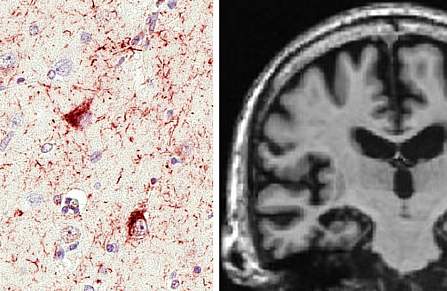
30 April 2019
A recently recognized brain disorder that mimics clinical features of Alzheimer’s disease has for the first time been defined with recommended diagnostic criteria and other guidelines for advancing and catalyzing future research. Scientists from several National Institutes of Health-funded institutions, in collaboration with international peers, described the newly-named pathway to dementia, Limbic-predominant Age-related TDP-43 Encephalopathy, or LATE, in a report published on April 30, 2019, in the journal Brain.
“While we’ve certainly been making advances in Alzheimer’s disease research — such as new biomarker and genetic discoveries—we are still at times asking, ‘When is Alzheimer’s disease not Alzheimer’s disease in older adults?’” said Richard J. Hodes, M.D., director of the National Institute on Aging (NIA), part of the NIH. “The guidance provided in this report, including the definition of LATE, is a crucial step toward increasing awareness and advancing research for both this disease and Alzheimer’s as well.”
Alzheimer’s is the most common form of dementia, which is the loss of cognitive functions — thinking, remembering, and reasoning — and every-day behavioral abilities. In the past, Alzheimer’s and dementia were often considered to be the same. Now there is rising appreciation that a variety of diseases and disease processes contribute to dementia. Each of these diseases appear differently when a brain sample is examined at autopsy. However, it has been increasingly clear that in advanced age, a large number of people had symptoms of dementia without the telltale signs in their brain at autopsy. Emerging research seems to indicate that the protein TDP-43 — though not a stand-alone explanation — contributes to that phenomenon.
What is TDP-43?
TDP-43 (transactive response DNA binding protein of 43 kDa) is a protein that normally helps to regulate gene expression in the brain and other tissues. Prior studies found that unusually misfolded TDP-43 has a causative role in most cases of amyotrophic lateral sclerosis and frontotemporal lobar degeneration. However, these are relatively uncommon diseases. A significant new development seen in recent research is that misfolded TDP-43 protein is very common in older adults. Roughly 25 percent of individuals over 85 years of age have enough misfolded TDP-43 protein to affect their memory and/or thinking abilities.
TDP-43 pathology is also commonly associated with hippocampal sclerosis, the severe shrinkage of the hippocampal region of the brain—the part of the brain that deals with learning and memory. Hippocampal sclerosis and its clinical symptoms of cognitive impairment can be very similar to the effects of Alzheimer’s.
“Recent research and clinical trials in Alzheimer’s disease have taught us two things: First, not all of the people we thought had Alzheimer’s have it; second, it is very important to understand the other contributors to dementia,” said Nina Silverberg, Ph.D., director of the Alzheimer's Disease Centers Program at NIA. In the past many people who enrolled in clinical trials likely were not positive for amyloid. “Noting the trend in research implicating TDP-43 as a possible Alzheimer’s mimic, a group of experts convened a workshop to provide a starting point for further research that will advance our understanding of another contributor to late life brain changes,” Silverberg explained. In addition to U.S. scientists, experts included researchers from Australia, Austria, Sweden, Japan, and the United Kingdom with expertise in clinical diagnosis, neuropathology, genetics, neuropsychology and brain imaging.
Supported by NIA, the workshop was held Oct. 17 and 18, 2018, in Atlanta, and co-chaired by Dr. Silverberg and Peter Nelson, M.D., Ph.D., from the University of Kentucky, Lexington, the lead author on the paper. As published in the report, outcomes included classification guidelines for diagnosis and staging of LATE as well as recommendations for future research directions.
